
The world has capitalized on numerous renewable energy resources by developing its energy infrastructure mainly around solar, biomass, and hydro energy. However, geothermal energy has not yet been developed at a significant scale, despite reports from 62 wells showing evidence of geothermal gradients ranging from 20.8 °C/km to 48.7 °C/km in various areas of the world. Recent studies suggest that Bangladesh also has a huge potential for geothermal energy.
Among numerous factors, the steady increase in energy production has played a prominent role in global development. Research into economics has identified a correlation that a nation’s gross domestic product (GDP) is commensurate with its ability to use energy. However, global energy demand solely depends on fossil fuels. Over-reliance on fossil resources increases economic, societal, and environmental risks throughout the world. Besides, the present scenario of electricity production is unable to meet increasing demand. Hence there persisted in a generation shortfall as seen in Figure 1 (a case study in Bangladesh), which must be met either by importing or utilizing the available resources more wisely. It is seen from Figure 1 that the demand forecast is higher than the maximum peak generation though both the two are increasing with time. However, according to the statistics of previous years, the extrapolated data in the year 2020–2021 shows that there will remain a generation gap in the upcoming years. Even the gap may increase due to the rapid growth of industrialization and populations.

In this circumstance, the effective utilization of renewable energy can create a sustainable energy future globally. Figure 1 shows that the demand forecast (14683 MW) and maximum peak generation (14513 MW) in the year 2021–21 are close to each other. Therefore, if renewable sources like geothermal energy can be added as a potential source of energy then the generation gap of around 500 MW can be minimized. However, establishing power production around solar, wind, hydro, and biomass is weather-dependent and so it is inefficient. On the other hand, geothermal energy is not completely weather dependent, while its generation capacity is very high. Hence, the addition of geothermal energy with the conventional grid system can reduce purchasing price of energy per unit area which eventually improves the GDP of a country. Conversely, a country’s development lies in its uninterrupted energy generation with high efficiency. Therefore, to aggregate continuous power with national energy generation using renewable resources, a promising solution is required. In this concern, geothermal energy utilization may be an option as it totally weathers independent and has the highest availability factor than of other renewables (Figure 2). Since the heat inside the earth’s surface will not be depleted and can ensure energy consistently at high efficiency with minimal environmental impact.

Despite the world having significant potential geothermal resources, limited effort has been expended towards development. Moreover, any significant steps have not been taken to establish a framework for exploring geothermal energy. In the case of Bangladesh, governmental organizations such as the Ministry of Water Resources and the Ministry of Environment have conducted a geological survey to identify the geothermal potential. Also, one private organization, Anglo MGH Energy, has invested in developing a geothermal power plant with a capacity of 200 MW. The project will generate steam power from a hydrothermal basin near Salander in the district of Thakurgaon. However, this facility is still in the planning phase.
However, geothermal energy harvesting is still in its early stages compared to other energy sources, rendering it difficult to adopt field investigation for evaluating these resources and their suitability. Only a few studies have reported the potentiality of geothermal energy but have fallen short of detailing possible applications and processes suitable for the world. This way it would help to fulfill the high pressure of future energy demand as the demand for global energy is increasing significantly. Thus, an extensive evaluation of potential geothermal resources and a pathway to efficient utilization is required.
Previous research didn’t show the prospects of geothermal power plant based on effective cost analysis, feasibility study, environmental concerns, comprehensive proposal, and so on
Geothermal Energy Potential
Renewable energy sources including geothermal energy can be integrated into the grid to implement hybrid energy systems that will help to mitigate the high demand for energy with low cost of energy (COE) and net present cost (NPC). Eventually, it will reduce the overall COE and so even the poor people can get access to electricity. Consequently, GDP will increase for developed and developing countries like Bangladesh. Economically, if geothermal power plant can be set up then more unemployed people can get opportunities for work. In rural areas, people will also be benefitted from this source of energy by resolving their energy demand and unemployment problems. On the other hand, environmentally, geothermal energy is viable for Bangladesh as it generates less environmental pollution, harmful wastes, radioactive materials, decay materials, and so on.
However, geothermal energy is one of the most powerful, natural, and renewable sources of energy globally. From the slow decay of radioactive particles in rocks, high temperatures are generated inside the earth which is a significant source of energy. In the case of developing countries like Bangladesh, renewable and conventional fuels are significant sources of future energy. Figure 3 illustrates the graphical representations of different potential locations for geothermal energy in northwest and southeast regions in Bangladesh. These potential locations are divided into 6 divisions, where the highlighted locations represent the highest potential of each division. However, the northwest having different geological aspects such as the hydro-geological settings, seismicity and earthquakes, cluster of basement faults and surface thermal anomalies indicate the existence of potential geothermal reservoirs at only a depth of a few kilometers below the earth’s surface. The geothermal gradient in this region ranges from 20.8° to 48.7 °C/km. Studies have shown the potential geothermal energy in Thakurgaon, due to the presence of some thermal manifestations and related evidence of the existence of some shallow aquifers.
Moreover, in the Bogra shelf region, Singra-Kuchma-Bogra is a promising and potential area. The Singra well, with over 150 °C bottom hole temperature holds the most auspicious position among the three areas. Barapukuria coal basin and the Madhyapara hard rock mine area are two other potential zones for geothermal energy, among which the latter was found with a temperature variation in the range of 67°–153 °C, indicating the presence of a low-temperature geothermal reservoir in the area. Moreover, it is found that the temperature at 2500 m below the earth’s surface in the northwestern tip of Bangladesh, near Salbanhat-1 well, was 79 °C and at a depth of 4,000 m it increased to 110 °C. Also, the GDH-65/11 well recorded 47 °C at a depth of 587m.
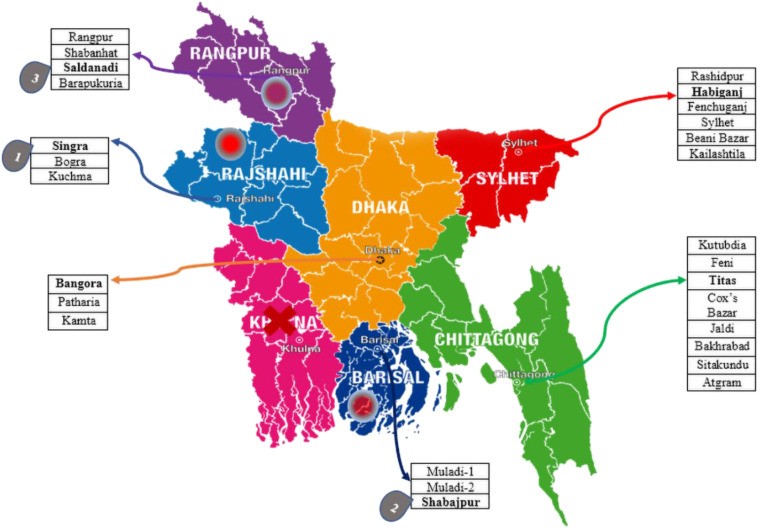
Also, the geothermal gradients at different locations in the northwest and southeast regions are shown in Figure 4 from which a comparison can be obtained between these two regions. The southeast region has a geothermal gradient from 19.8° to 27 °C/km. Based on the presence of some thermal springs, the Sitakunda hilly area has become a place of interest. From Figure 4, the highest gradient in the southeast is 27 °C/km in the Semutang-1 well located in Khagrachari. In general, the geothermal gradients in the northwest suggest more favorable conditions compared to the southeast. The wells at Thakurgaon and Barapukuria show the highest temperature gradients with values of 34.2 °C/km and 48.7 °C/km, respectively.
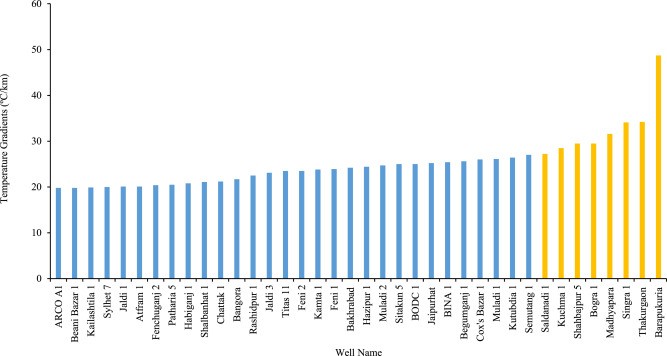
However, the subsurface temperature distribution at different depths leads to the feasibility analysis for energy extraction from geothermal resources. Figure 5 illustrates the subsurface temperature distribution of different areas in southeast regions. The depth versus temperature is roughly linear, so the temperature according to depth can be calculated and can be used to design a suitable energy extraction process in these sites. For example, it is reported that the temperature required for the dry steam and flash steam types of power plants is recommended to be >150 °C and for the binary cycle power plant the required temperature can be <100 °C which is discussed further in this study. Altogether this information supports the presence of several suitable geothermal sites across Bangladesh.
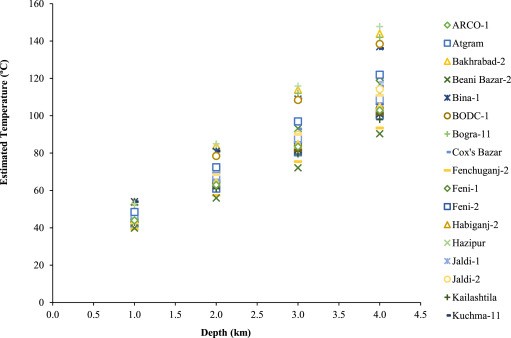
Favourable Geothermal Sites
In the case of Bangladesh, the delta system developed by two rivers, the Ganges and the Brahmaputra is considered one of the largest deltas in the world. This delta supplies a large amount of sediment from the Himalayas. However, Bangladesh is situated in the northeast Indian plate closed to the edge of the Indian craton. The tectonic features of Bangladesh are dominated by a huge geosynclinal basin and a stable pre-Cambrian platform. It is further separated by a narrow northeast-southeast trending hinge which is also known as Palaeo continental slope. According to Guho et al. the geological map of Bangladesh can be divided into five divisions. They are Sub-Himalayan foredeep, Bogra slope, Folded belt, Deep Sedimentary Basin, and Garo-Rajmahal Gap. These five divisions are further divided into different subdivisions which are summarized with their special features in Table 1 according to the temperature gradients and the ranges of temperature at different depths. Among the different regions, the Sub-Himalayan foredeep shows relatively low-temperature gradients which exhibits less feasibility for geothermal energy extraction. On the contrary, the Garo-Rajmahal gap and Rangpur Saddle show comparatively higher potential for energy extraction. This is because of having included the northern slope of Rangpur Saddle with Himalayan Foredeep. Moreover, at a depth of 80 m in Thankurgaon region exhibits the warm water up to 36 °C, which shows the potentiality for installations of geothermal energy harnessing systems. However, the high surface temperature distributions can also lead to a drilling dept at a reasonable cost, which shows the feasibility of implementing a geothermal power plant. It can be seen from the regions of Bogra slope and Folded belt basin that the subsurface temperature at a depth of 1–4 km varies within 50–150 °C which is also can be a part of geothermal resources. Though the temperature gradients in the Folded belt are relatively lower than Rangpur Saddle and Bogra slope this region is more favorable than the Deep sedimentary basin regions which include Sylhet, Mymensingh, Pabna, Barisal, Madhupur, Faridpur, and Chandpur. These regions have less feasibility for geothermal energy extraction.
Table 1. Location and temperatures recorded at the various geothermal site.
Division | Subdivisions | Temperature gradient | The temperature at variable depth (km) (1–4 km) | Comments | References |
Sub-Himalayan foredeep | Northern slope of Rangpur saddle | 21.1 °C–79 °C | 2.5 °C–111 °C | Relatively low thermal gradients Barely feasible | |
Panchagarh districtt | |||||
Salbanhat | |||||
Rangpur saddle and the garo-rajmahal gap | Rangpur district | 35 °C–47 °C | 45.7 °C–115 °C | High surface temperatures Reasonable drilling depth | |
Thakurgaon | |||||
Dinajpur district | |||||
Malda | |||||
Barapukuria | |||||
Western part of the Rangpur saddle | |||||
Bogra slope | Singra | 27 °C–31.6 °C | 52 °C–147.8 °C | Potentially favorable | |
Bogra | |||||
Kuchma | |||||
Deepsedimentary basin | Madhupur | 16.8–20.1 °C (Lower temperature gradient) | 39.5 °C–104 °C | · Loaded with cool sediment · Geothermal gradients are very low · Barely feasible | |
Pabna | |||||
Mymensingh | |||||
Chandpur high | |||||
Barisal | |||||
Faridpur trough | |||||
Sylhet | |||||
Folded Belt | · Sitakund-5 · Bakhrabad | 23.0 °C | 49 °C–118 °C | · Geothermal gradients relatively low · Feasible |
3. Demonstrated technologies to convert geothermal energy
Nature offers geothermal energy in different forms, namely, Geo-pressured brines, magma, hot, dry rocks, hydrothermal fluid and ambient ground heat. However, the whole process in the utilization of geothermal energy can be divided into Exploration and Extraction as described in the following sections.
Exploration

A concept of the total life cycle of geothermal energy is illustrated in Figure 6
In geothermal systems, physical parameters like temperature, pressure, porosity, chemical content of fluid, and permeability are the most important. With current conventional geophysical methods, it is challenging to measure all these parameters although measuring temperatures, electrical resistivity, thermal conductivity, seismic velocity, density, and magnetization is more easily achieved. The methods used for geothermal exploration include geochemical sampling and analysis, geological mapping, geophysical methods, and exploration drilling. An integrated approach is used before proceeding to the most costly and critical process which is drilling. An approach consisting of all of the above processes establishes a conceptual model of a subsurface geothermal system. After establishing a potential location, the following processes (Geology, Geochemistry, and Geophysics) are generally followed.
In the geology phase, a detailed geographical map is generated considering geothermal fluids and their surroundings, surface alteration minerals, and tectonic features. Also, ground-water levels along with a detailed mapping of groundwater, lakes, and springs should be conducted. Samples of thermal water, gases, and steam are generally analyzed for chemical elements (major and trace elements) and stable isotopes (oxygen, hydrogen, carbon, and sulfur) in the geochemistry phase.
In the geophysics phase, a range of different methods and applications are enlisted. The thermal method is the direct measurement of temperature, heat, and properties of a geothermal system. It includes measurement of soil temperature, detailed geothermal surface mapping, temperature measurement in 20–100 m gradients, airborne infrared, and local heat flow surveys. The electrical method is also known as the electrical resistivity method. Among the two-resistivity surveys, a shallow survey is performed with central-loop transmission electron microscopy (TEM) soundings or audio-magneto telluric (AMT) soundings where direct-current (DC) methods can also be used, whereas the deep survey is performed by magnetotelluric (MT) soundings. Gravity measurements are used to detect a difference in density among geological formations. Different gravitational forces result from different densities and are measured in mGal (milligal) or 10-3 cm/s2. This method can be used for discovering heat sources in volcanic rock. Magnetic measurements locate hidden intrusions, estimate their lengths, trace buried dykes and faults, and find areas of degraded magnetization caused by thermal activity. For measuring the distribution of sound velocity, anomalies existing in the earth, and attenuation of the sound wave, seismic methods are used. With this method two types of waves are generated, a P wave that travels in a similar direction of the wave and a slower S wave that travels perpendicular to the wave direction. A compilation of all these features establishes a conceptual model of the geothermal system enabling the most promising areas for production to be determined.
Extraction
Generally, energy is extracted by supplying generated hot steam to a turbine and thus producing electricity. Geothermal power plants mainly consist of three developed configurations, Binary Cycle power plant, Dry Steam, and Flash Steam. Amongst dry steam power is the simplest and oldest system where steam having 150 °C or more is used to turn the turbines. For this system, two wells are needed for rising the steam and injecting the water. Water is injected, which contacts the high-temperature rocks and produces steam that is pumped through the production well. The water is recycled in a closed-loop system. In flash steam power systems, hot and highly pressurized water is pulled into a lower pressure tank by using flash steam stations to run the turbine. This requires temperatures of ≥180 °C and produces electricity in a more efficient way than the dry steam process. In a binary cycle configuration, the vapour is produced by transferring heat into a low boiling point organic fluid. The advantage of this type of power plant is that it can work at reduced temperatures. The typical efficiency lies within 10–13%. It is considered as the most developed and efficient geothermal power plant, and here the efficiency is directly proportional to the temperature (up to about 180 °C). For water as fluid and reservoir temperature >220 °C flash systems or combined binary and flash systems are used. The binary cycle is favoured for use when the temperature is within 100 °C–220 °C. At temperatures of 50 °C–150 °C, heating rather than power generation is an option. However, the binary cycle can also be used.
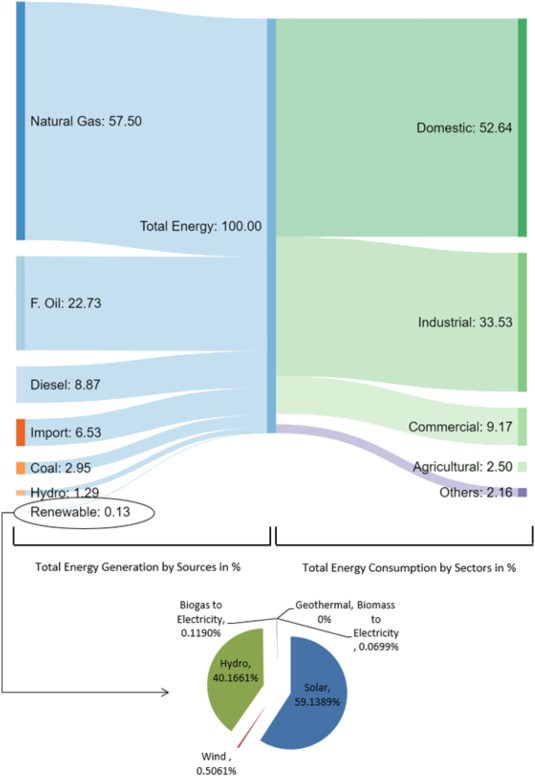
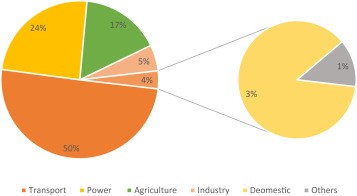
Figure 9 summarizes the potential uses of extracted energy from geothermal resources in agriculture and agro-industry sectors. In between low to an intermediate temperature (20 °C–150 °C), geothermal energy can be utilized in a direct application that includes space heating, heat pumps for heating and cooling, aquaculture, and various industrial processing systems. For direct electricity and steam generation temperature resources (70 °C–300 °C) are preferred. According to Bakos et al., geothermal resources play a vital role in agro-industry and agricultural applications. These applications can be categorized into four sectors including greenhouse heating, agro-industrial process, aquaculture (fish and algae production) and soil heating. However, in agricultural and agro-industrial processing, geothermal resources only require low to intermediate temperature ranges, hence exploiting the waste heat and cascading water from a geothermal power plant are feasible. For instance, drying technology is a critical process spanning many agricultural sectors to ensure the availability of food with high nutrition and in avoiding wastage. In this case, using geothermal resources having low to medium enthalpy with temperature less than 150 °C, and/or latent heat from geothermal power plants and hot well water would be a more cost-effective application.

As shown in Figure 10, it is evident that neighboring countries like India, China, and Nepal are already utilizing their geothermal resources in agriculture sectors like fish farming, drying along with industrial applications including space heating, heat pump, and in the domestic sector for bathing and swimming.

From the analysis of global geothermal utilization under similar temperature gradients, some plausible geothermal energy utilization processes that can be applied to Bangladesh are presented. The uses of geothermal energy can be categorized into direct use and indirect use. In indirect use, geothermal energy is used to produce electricity via dry steam, flash steam, or binary cycle power plants. For direct use, the most promising utilization is in agricultural drying, industrial application, aquaculture, and irrigation.
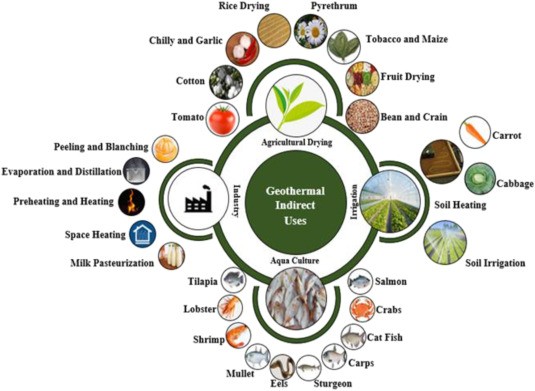
Bangladesh is summarized in Table 2. Here, an effective geothermal energy management model is also developed considering the suitable conditions of Bangladesh. The direct uses of geothermal energy which are most suitable for Bangladesh are ranked in descending order of effectiveness in Figure 12 and suggest agricultural drying and aquaculture are the most likely ‘best bet’ applications in the short term. The effectiveness is ranked according to the operational time, implementation cost, and economic values of each sector. Bangladesh is predominantly considered as an agricultural country in which agriculture plays an accelerating role in economic development. Peoples living in this country, directly and indirectly, depend on it all year round. Also, being a tropical country and having fertile soil, it offers naturally favorable conditions for harvesting crops, vegetables, fruits, and spices. The economic value of this sector is comparatively higher than all other sectors and the implementation cost for geothermal energy extraction will not be so high as nature offers favorable weather conditions already. Again, in Bangladesh, the fisheries and the aquaculture industry lead an important role in mitigating malnutrition and protein deficiency. Almost 60% of the total animal protein consumption comes from fish industries. This sector has also a great contribution to employment generation and foreign exchange earnings. However, during winter the water temperature in Bangladesh tends to drop below 15 °C which is not supportive for favorable production whereas for the highest production the recommended optimal temperature ranges between 22 to 30 °C. For this, geothermal energy can easily be extracted for heating as the geothermal potentials of Bangladesh support favorable conditions in this regard which leads to a reasonable cost for implementation. Using geothermal energy for fish drying and aquaculture will also develop the industry and promote a renewable energy-based economy. Though the economic value of aquaculture sectors is minor than the industrial perspective, it costs comparatively lower than industry in terms of implementation. This is because industrial uses need comparatively higher heating facilities than aquaculture heating which results in drilling more depth for acquiring suitable temperature and leads to a higher cost. In Bangladesh, several irrigation techniques are also used such as – power pumps, tube wells, canals, etc. Geothermal resources can be used for soil heating thus maintaining constant ground temperature to increase yields. The soil temperature is maintained at about 20–30 °C. Geothermal water can also be used in irrigation keeping in mind the chemical composition and salinity of the water. However, the effectiveness of using geothermal energy in other sectors is relatively the lowest in Bangladesh in terms of cost.
Table 2. Effectiveness of indirect uses of geothermal energy, Extracted from
Application | Economic value | Operation time | Implementation Cost and Logistics |
Agricultural drying | Potentially dryable 1.288 Mega Tons (Mt) of vegetables, 3.830 Mt of fruits and 2.594 Mt of spices | 12 months | Low – Medium |
Aquaculture and processing | 4.14 Mt | 6 months (winter season) | Low- Medium |
Industry | 81,645 tons of tea, 74,699 thousand soft drinks and cigarette, 891.424 Mt knitwear | 12 months | High |
Irrigation | 18,820 thousand acres of land cultivable land | 8–12 months | Medium – High |

Geothermal Plants
It is well established that geothermal energy can be directly extracted as heat in order to produce electricity incorporating the principle of a steam power plant. Figure 13 demonstrates one such geothermal-based electricity production pipeline. In its simplest form, heat energy is captured using water which then, in turn, produces steam to drive a turbine-based electricity generation system. A range of different processes for extracting geothermal energy have been configured and are typically tailored to the geothermal temperature gradients of the region.

As previously discussed, Bangladesh has several geothermal energy-rich locations with the potential to develop geothermal energy. Further analysis of the 62 exploratory wells dug in various regions of Bangladesh has been used to classify the range of geothermal temperature gradients. Based on this data it could be said that there are 6 divisions of Bangladesh in which geothermal-based energy conversion plants can be effectively and economically established. Figure 14 uses a tree map of geothermal-rich areas in Bangladesh classified into 6 divisions. The tree map denotes the geothermal gradient potential by area, where a larger area represents higher geothermal potential. From Figure 14 it is evident that the northernmost division Rangpur and Sylhet, the southernmost division Chittagong have the most effective geothermal potential, where Thakurgaon and Barapukuria of Rangpur division have the highest geothermal gradient. From these regions, fluid with high enthalpy can be supplied for the reservoir of a geothermal power plant. On the other hand, Barisal and Dhaka divisions along with low-temperature gradients compared to Rangpur and Chittagong regions. From Table 1 it is also found that Faridpur trough, Pabna, Madhupur, Chandpur also have relatively low-temperature gradients. These areas are not considered suitable for developing geothermal power plants since the cost of drilling is very high.

Effective cost analysis for a establishing a geothermal plant
The cost for establishing a geothermal plant can be predicted by analyzing the capital cost, operation and maintenance cost, and equipment cost during installation, commissioning and power generation. Each cost depends on the project requirements such as turbine, air-cooled condenser, PEM electrolyser, water heater, and many more. Furthermore, the cost range depends on the type, well productivity, and geothermal power plant’s geothermal economic parameters.
Initially, to evaluate economic viability, the estimated capital costs for geothermal plants are required. Because the capital cost is fixed, the one-off costs are incurred in purchasing the land, buildings, and equipment used to produce goods or render services. A geothermal power plant’s capital cost can be ranged between 1,092$ and 347,100$ (Table 4), where turbine and PEM (Polymer Electrolyte Membrane) electrolyser cost is higher than other equipment. Hydrogen production quantities are negligible at low current density, resulting in a very significant capital cost per unit of hydrogen produced. For this reason, the capital cost of the PEM electrolyser is intensive. It would be the next concern for further research in the future. According to Table 4, the maintenance and operational cost are ranged between 58.50 and 713,700$, in which the highest price is carried out by an air-cooled condenser. The air-cooled condenser cost depends on ITD (Initial Temperature Difference). Cost of an air-cooled condenser increase with decreasing ITD. Nevertheless, the purchase cost and specific exergetic cost are maximum for the PEM electrolyzer. Consequently, from Table 4, it can be concluded that PEM can be the primary concern regarding price for further research.
Table 4. Summary of cost analysis for different categories with related equations.
Categories | Area of investment | Cost ($) | Cost range ($) | Required equations |
Capital Cost | Turbine | 56,589 | 1,092–347,100 | · • · Here, · · • |
Air cooled condenser | 13,650 | |||
Pump | 8,970 | |||
PEM electrolyzer | 347,100 | |||
Heat exchanger | 18,018 | |||
Water preheater | 5,460 | |||
Other equipment | 1,092 | |||
Operation and maintenance cost (OM) | Turbine | 2964 | 58.50–713,700 | |
Air cooled condenser | 713,700 | |||
Pump | 468 | |||
PEM electrolyzer | 18,135 | |||
Heat exchanger | 956 | |||
Water preheater | 293 | |||
Other equipment | 58.50 | |||
Purchased equipment cost | Turbine | 1066.700 | 20,500–6,531,300 | · • Based on Aspen Plus economic analysis library |
Air cooled condenser | 257,300 | |||
Pump | 168,700 | |||
PEM electrolyzer | 6,531,300 | |||
Heat exchanger | 339,600 | |||
Water preheater | 102,700 | |||
Other equipment | 20,500 | |||
Energetic and exergetic cost | Pump | 13.58 | 2.246–19.68 | · • Specific cost of the exergy of product, |
Heat exchanger | 2.246 | |||
Turbine | 6.496 | |||
Air cooled condenser | 4.234 | |||
PEM electrolysis | 19.68 | |||
Electrolysis water preheater | 5.475 | |||
Economic parameters | Surface cost | 45.75 × 106 | – | · • · • |
OM cost | 3755.33 | |||
Subsurface cost | 45.76 × 106 | |||
Initial cost | 91.52 | |||
Macro-economic [126] | Fuel cost escalation rate (%) | 4.5 | – | – |
Debt interest ratio (%) | 8 | |||
Electricity export rate | 91.3 |
However, the general and macro-economic parameters must use to measure the geothermal plant’s cost, which can be obtained from the equation mentioned in Table 4. In economic parameters, the surface and subsurface cost is so much higher than other parameters.